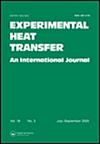Experimental study on heat transfer characteristics between particle flow and wall
IF 2.9
3区 工程技术
Q2 ENGINEERING, MECHANICAL
引用次数: 0
Abstract
ABSTRACTThis study experimentally and numerically investigated the characteristics of heat transfer between particle flow and a cylindrical wall. The theoretical model of the heat transfer coefficient calculation was verified and modified according to experimental data. In the experimental scheme, the temperature at the axis of the cylinder under different conditions was measured to determine the effects of temperature, relative motion velocity, and cylinder diameter on the heat transfer coefficient between the particle flow and the cylindrical wall. Results revealed the benefits of using high temperature for increasing the heat transfer coefficient. The relative motion velocity between the wall and particles had no significant effect on the heat transfer coefficient. Furthermore, the change in the heat transfer coefficient was less than 10% in the range of relative velocity v = 0.03 to 0.12 m·s−1 between the wall and particles. The heat transfer coefficient almost independents on cylinder diameter under constant particle diameter conditions.KEYWORDS: Particle flowtheoretical heat transfer modeldiscrete element methodrelative motion velocitythermal radiation Disclosure statementNo potential conflict of interest was reported by the author(s).颗粒流与壁面传热特性的实验研究
摘要本文对颗粒流与圆柱壁面之间的传热特性进行了实验和数值研究。根据实验数据对传热系数计算的理论模型进行了验证和修正。在实验方案中,通过测量不同条件下圆柱体轴线处的温度,确定温度、相对运动速度和圆柱体直径对颗粒流与圆柱体壁面传热系数的影响。结果表明,采用高温对提高换热系数有一定的好处。壁面与颗粒之间的相对运动速度对换热系数无显著影响。在相对速度v = 0.03 ~ 0.12 m·s−1范围内,壁面与颗粒之间的换热系数变化小于10%。在颗粒直径不变的条件下,换热系数几乎与柱体直径无关。关键词:颗粒流理论传热模型离散元方法相对运动速度热辐射披露声明作者未报告潜在的利益冲突。
本文章由计算机程序翻译,如有差异,请以英文原文为准。
求助全文
约1分钟内获得全文
求助全文
来源期刊

Experimental Heat Transfer
工程技术-工程:机械
CiteScore
6.30
自引率
37.10%
发文量
61
审稿时长
>12 weeks
期刊介绍:
Experimental Heat Transfer provides a forum for experimentally based high quality research articles and communications in the general area of heat-mass transfer and the related energy fields.
In addition to the established multifaceted areas of heat transfer and the associated thermal energy conversion, transport, and storage, the journal also communicates contributions from new and emerging areas of research such as micro- and nanoscale science and technology, life sciences and biomedical engineering, manufacturing processes, materials science, and engineering. Heat transfer plays an important role in all of these areas, particularly in the form of innovative experiments and systems for direct measurements and analysis, as well as to verify or complement theoretical models.
All submitted manuscripts are subject to initial appraisal by the Editor, and, if found suitable for further consideration, to peer review by independent, anonymous expert referees. All peer reviews are single blind and submission is online via ScholarOne Manuscripts. Original, normal size articles, as well as technical notes are considered. Review articles require previous communication and approval by the Editor before submission for further consideration.
 求助内容:
求助内容: 应助结果提醒方式:
应助结果提醒方式:


